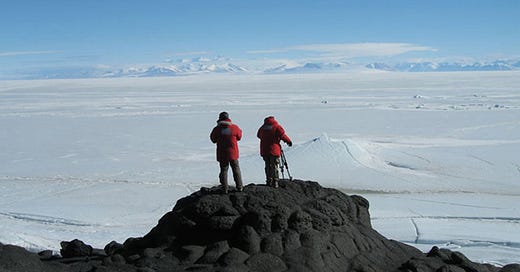Heroes of the Zeroes: Encounters at the End of the World / Grizzly Man
Heroes of the Zeroes is a daily, alphabetical look back at the 365 best films of 2000-2009. Today's entry counts as two films.
"Encounters at the End of the World" / "Grizzly Man" Rated G / Rated R 2007 / 2005
For someone avoiding “another film about penguins” in 2007’s “Encounters at the End of the World,” Werner Herzog captured the Zeroes’ most memorable waddle.
He observed a loner breaking from his pack, sprinting for a distant mountain toward certain doom, and driven by … what? Curiosity? Depression? Insanity? The question is quintessential Herzog — haunting, existential and forged by a kindred bond to obsessive spirits.
Through “World” and 2005’s “Grizzly Man,” Herzog studied humans in nature and controversial views about roles we play and knowledge we can reasonably acquire.
“World” took Herzog to Antarctica’s southernmost point, where, as interviewees say, scientists and tradesmen jump off the map and meet where the lines converge.
Unsurprisingly, Herzog captured unparalleled nature-film beauty. (Journeying with divers under the ice shelf was like sinking into bliss.) But it was little explosions of discovery through which Herzog scraped at ruminations of our place on the planet.
Do art and intelligence flicker in protective practices of single-celled organisms? What perpetuates the order of behavior in nature, and what prevents or, in the penguin’s case, precipitates a sudden shift? How can someone tangibly monitor something that both appears and is gone in one hundredth-billionth of a second?
Damnably frustrating and fascinating, these questions deconstruct Earth’s DNA in a scientific process that goes beyond statistics to ancestry or spirituality — an idea that we’re but witnesses and valets who are here and, sooner than we think, will be gone.
Herzog identified one such fleeting existence in Timothy Treadwell, aka “Grizzly Man.” An untrained studier of bears, Treadwell violated rules of football-field distance from Alaskan grizzlies for 13 consecutive summers, at times as close to them as a quarterback to a center. Foxes became like his pets, and there was fearlessness beneath his singsong cadence.
As in “Capturing the Friedmans,” Treadwell’s video camera became his confessional, and the monologues, rants and laments left behind feel like breadcrumbs on the trail to his death at the hands of, yes, a grizzly.
Treadwell was a Whitman’s sampler of contradictions and multitudes — a “kind warrior” who found salvation from alcoholism among the bears, but also had an incandescent rage toward those who would oppose him.
Herzog forgoes judging Treadwell’s disputed methods or questionable mental state — letting viewers decide based on footage that suggests Treadwell essentially sought some sort of transmutation from flesh to fur.
But whether you find Treadwell a civil-disobedience hero a la Henry David Thoreau or a loon who had it coming, his love of nature arguably persisted even as life and limb were ripped from him. He died doing the only work he ever truly wanted. (Audio of his death exists, but it’s purposefully unheard, with vivid descriptions of vivisection and a wrenching scene in which Herzog barely keeps his composure listening.)
“Arctic Tale,” “Earth” and “March of the Penguins” have their place for introducing nature’s “cuter” wonders to younger viewers. In “World” and “Grizzly,” Herzog challenged viewers by examining, with unforgettable ferocity, the urges, desires, chaos, serenity and hostility in our larger world.
object classid="clsid:d27cdb6e-ae6d-11cf-96b8-444553540000" width="640" height="385" codebase="http://download.macromedia.com/pub/shockwave/cabs/flash/swflash.cab#version=6,0,40,0">



